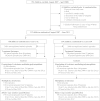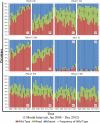Comparative impacts over 5 years of artemisinin-based combination therapies on Plasmodium falciparum polymorphisms that modulate drug sensitivity in Ugandan children
- PMID: 24610872
- PMCID: PMC4110461
- DOI: 10.1093/infdis/jiu141
Comparative impacts over 5 years of artemisinin-based combination therapies on Plasmodium falciparum polymorphisms that modulate drug sensitivity in Ugandan children
Abstract
Background: Artemisinin-based combination therapies, including artemether-lumefantrine (AL) and dihydroartemisinin-piperaquine (DP), are recommended to treat uncomplicated falciparum malaria. Sensitivities to components of AL and DP are impacted by polymorphisms in pfmdr1 and pfcrt. We monitored changes in prevalences of polymorphisms in Tororo, Uganda, from 2008 to 2012.
Methods: Polymorphic loci in pfmdr1 and pfcrt were characterized in samples from 312 children randomized to AL or DP for each episode of uncomplicated malaria (50 samples per arm for each 3-month interval) utilizing a fluorescent microsphere assay. Treatment outcomes and impacts of prior therapies were also characterized.
Results: Prevalence increased significantly over time for pfmdr1 N86 (AL: odds ratio [OR], 2.08 [95% confidence interval {CI}, 1.83-2.38]; DP: 1.41 [95% CI, 1.25-1.57]), pfmdr1 D1246 (AL: 1.46 [95% CI, 1.29-1.64]; DP: 1.36 [95% CI, 1.23-1.50]), and pfcrt K76 (AL: 3.37 [95% CI, 1.85-6.16]; DP: 5.84 [95% CI, 1.94-17.53], and decreased for pfmdr1 Y184 (AL: 0.78 [95% CI, .70-.86]; DP: 0.84 [95% CI, .76-1.50]); changes were consistently greater in the AL arm. Recent AL treatment selected for pfmdr1 N86, D1246, and 184F in subsequent episodes; DP selected for the opposite alleles.
Conclusions: Genotypes with decreased sensitivity to AL components increased over time. This increase was greater in children receiving AL, suggesting that the choice of treatment regimen can profoundly influence parasite genetics and drug sensitivity.
Clinical trials registration: NCT00527800.
Keywords: Plasmodium falciparum; artemether-lumefantrine; dihydroartemisinin-piperaquine; pfcrt; pfmdr1.
© The Author 2014. Published by Oxford University Press on behalf of the Infectious Diseases Society of America. All rights reserved. For Permissions, please e-mail: journals.permissions@oup.com.
Figures



Comment in
-
Artemisinin combination therapies and malaria parasite drug resistance: the game is afoot.J Infect Dis. 2014 Aug 1;210(3):335-7. doi: 10.1093/infdis/jiu142. Epub 2014 Mar 8. J Infect Dis. 2014. PMID: 24610873 No abstract available.
References
-
- World Health Organization. Guidelines for the treatment of malaria. Geneva, Switzerland: WHO; 2010.
-
- Nosten F, White NJ. Artemisinin-based combination treatment of falciparum malaria. Am J Trop Med Hyg. 2007;77:181–92. - PubMed
-
- Dorsey G, Kamya MR, Singh A, Rosenthal PJ. Polymorphisms in the Plasmodium falciparum pfcrt and pfmdr-1 genes and clinical response to chloroquine in Kampala, Uganda. J Infect Dis. 2001;183:1417–20. - PubMed
Publication types
MeSH terms
Substances
Associated data
Grants and funding
LinkOut - more resources
Full Text Sources
Other Literature Sources
Medical

